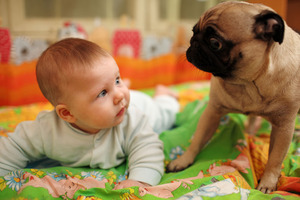Anyone who has ever loved a dog might be interested in a new study out of Budapest that sheds light on why we talk to our dogs as if they were babies. Researchers at the Hungarian Academy of Sciences are reporting that a dog’s communicative skills are, in fact, much like that of a 6-month-old baby. The study’s results “support the notion that dogs are sensitive to the cues of signaling humans’ communicative intent in a way that is analogous to preverbal human infants,” said the author, Josef Topel, an associate professor in the Comparative Behavior Research Group at the Institute for Psychological Research.

The research seems to confirm what we already know intuitively: that dogs, and babies, understand and anticipate their owner’s (their parent’s) intentions mostly through nonverbal communication—like eye contact and body language––although the pitch of our voice is important—as it is to a baby.
The study “Dogs’ Gaze Following Is Tuned to Human Communicative Signals,” in the January 5, 2012 issue of Current Biology was simple enough. Researchers showed 16 dogs two different videos. In the first video, a woman looks at a dog and says, “hi dog,” in a high- pitched voice. Using an eye-tracking technique, the same used to check the development of a baby, the woman then turns towards a plastic pot sitting on an adjacent table. In the second video, the woman avoids eye contact with the dog, and says “hi dog” in a lower pitch, and then looks at the plastic pot on the table. It’s not surprising that the dogs that made eye-to-eye contact, and were addressed in a high-pitched voice, were more likely to follow the woman’s eyes to the plastic pot, as if able to read her intent. This is the kind of skill you would expect to see in a 6-month-old child, according to the report.
Researchers are hopeful that the same eye-tracking method used in this experiment will also be useful in others that measure a dog’s cognitive processing, like its memory and ability to reason. Meanwhile, this study is important, according to Adam Goldfarb, director of pet care issues at the Humane Society of the United States,because it reminds us just how communicative our canines and humans can be. “This should reinforce that if we want our dog’s attention, we should be clear about it,” he said.
“Those people who talk to their dog in a baby-talk voice, they should keep it up,” he said. “Your dog will pay more attention.”









